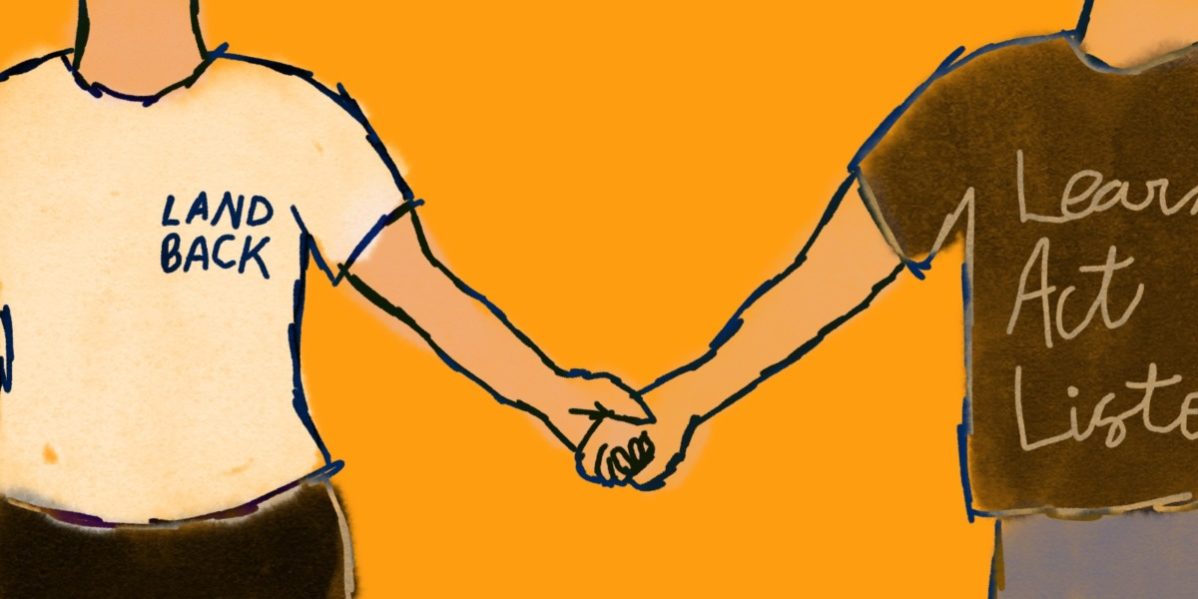Canada’s first National Day for Truth and Reconciliation brings an opportunity to not only recognize the atrocities committed against the Indigenous populations of the country, but also the humbling realization that any understanding of Canada’s identity is incomplete without understanding the history, traditions, and unique stories of the Indigenous peoples.
With that in mind, the Dialog has prepared six ways you can demonstrate your support for Indigenous issues, culture and communities which go beyond the National Day for Truth and Reconciliation.
Opportunities offered at GBC
You can find opportunities to learn more about the cultures, histories and traditions of Indigenous communities right here at George Brown College. The Indigenous Services team at GBC hosts events, workshops and social gatherings throughout the year. Most of the workshops are led by the team’s knowledge & wisdom keeper, Pauline Shirt, who has a lifetime of knowledge and experience that has been passed down through generations.
Their next event from the Indigenous Knowledge Keepers Series will take place at 12:00pm on October 1. The free virtual event will feature keynote speaker Chief Cadmus Delorme of the Cowessess First Nation. Chief Delorme was named among one of CBC Saskatchewan’s Future 40, which celebrates the province’s new generation of leaders, builders and change-makers under the age of 40. He will speak about the importance of recognizing the truth first so that reconciliation can prevail. Click here for more information on how to register for this event.
The Indigenous Services team also offers many other workshops that highlight different aspects of Indigenous cultures such as Four Sacred Medicine Teachings, tobacco planting, herbal and harvest knowledge workshop, hand drum making, sweetgrass braiding and more.
You can find more information about the workshops here.
Land Acknowledgement
Ontario is home to about 375,000 Indigenous people. Learning the Indigenous names of the traditional territories and lands that you are using is great way to not only acknowledge, but also get to know more about the rich history and traditions of Canada.
The Casa Loma campus at GBC is located in close proximity to an area with significant Indigenous history. The areas surrounding Spadina Avenue and Davenport Road was once a trail that ran east and west all throughout the Toronto area. This trail was connected to the bottom of the Baldwin Steps at Casa Loma.
Whose Land, which is both an app and a website, can help you find more information about Indigenous lands and more.
Whose Land works as an educational tool that offer information about Indigenous lands across the country. Besides mapping out traditional territories across Canada, the app also offers information about treaties and agreements between the government and Indigenous communities.
Books to Read
Reading books that cover different aspects of Indigenous history and cultures is one of the best ways to have a deeper understanding of Indigenous history.
You can also find great books written by Indigenous authors. A Mind Spread Out on the Ground by Alicia Elliott, Clifford by Harold R. Johnson, Hope Matters by Lee Maracle, Columpa Bobb and Tania Carter are only a few great books to try out among a rich body of work created by Indigenous authors.
Alicia Elliott, who delves into the ways colonial violence and loss of language impacts Indigenous peoples in modern-day, won gold at the National Magazine Awards in 2017.
Finding Indigenous Artworks
You can find a rich collection of cinema, artworks and festivals that celebrate different aspects of Indigenous peoples. The National Film Board of Canada offers free membership and their Indigenous Cinema collection showcases works of Inuit, Métis and First Nations filmmaking spanning more than 50 years.
You can also check out the six-day imagineNATIVE Film+ Media Arts Festival starting on October 19. This charitable organization aims to offer a greater understanding of Indigenous artistic expressions by showcasing original Indigenous films and media artists.
Volunteer Opportunities
What better way to learn more about the lives of Indigenous peoples than connecting with them through volunteering?
There are different organizations based in Toronto that work specifically for the welfare and empowerment of Indigenous communities. The Native Canadian Centre of Toronto, Metis Nation of Ontario, Aboriginal Education Centre, Ontario Federation of Indigenous Friendship Centre are some of the organizations where you can not only access different workshops and community events but also find opportunities to volunteer. If you’re interested, keep an eye on their website for volunteering and part-time work opportunities.
Places to Go
The Greater Toronto Area has a lot of places and experiences to offer non-Indigenous people great opportunities to connect with Indigenous communities. Indigenous Experience Ontario offers cultural experiences, lodging in Indigenous areas, Pow Wows and more. They also offer virtual tours that can come in handy during COVID restrictions. You can also check out the Royal Ontario Museum for their Indigenous Voices series. Taking a stroll in David A. Balfour Park in Deer Park and Étienne Brûlé Park near the Humber River can offer more than sightseeing, as both places have a rich Indigenous history waiting to be discovered.


